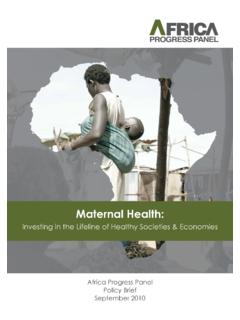Transcription of A Public Health Needs Assessment - Maryland
1 A Public Health Needs Assessment _____. Prepared by Public Health Services, September 2014. Martin O'Malley, Governor Joshua M. Sharfstein, , Secretary Anthony G. Brown, Lt. Governor Dept. of Health and Mental Hygiene 201 West Preston Street, 5th Floor. Baltimore, Maryland 21201. 410-767-6500 or 1-877-463-3464. Table of Contents Needs Assessment Purpose 3. Maryland Demographics 4. Access to Care 6. Community Health 11. Cancer 11. Chronic Disease 14. Infectious Disease 20. Environmental Health 24. Maternal and Child Health 32.
2 Oral Health 36. Tobacco 38. Emergency Preparedness 41. Patient Safety 43. Moving Forward: Strategic Use of Data and Technology 45. Appendices 46. A: SHIP Partners 46. B: VDU Data Portals 50. 2. Needs Assessment Purpose The mission of the Department of Health and Mental Hygiene (the Department) is to protect, promote and improve the Health and well-being of all Maryland citizens in a fiscally responsible way. The Department's mission touches the life of every citizen in Maryland and is evident in the scope and depth of the programs, offices and administrations that fall within the Public Health Services (PHS) branch.
3 PHS works to improve the Health status of individuals, families and communities through prevention, early intervention, surveillance and treatment. To accomplish this mission, PHS engages with local and community stakeholders ranging from neighborhoods to local Health departments, community-based organizations and faith based institutions. Hospitals and Health care systems, clinical practices, academic institutions and state partners, including other state government agencies, also contribute to the success of Public Health in Maryland .
4 The purpose of this Needs Assessment is to understand the Health status of Maryland 's diverse communities with a focus on populations who experience poorer Health outcomes. The Assessment provides a foundation for the general Public , community and state leaders to understand the Health Needs of Maryland . A majority of the data and Assessment for this process occurs through the Maryland State Health Improvement Process (SHIP) housed in SHIP functions as both a mechanism for ongoing data Assessment to identify Health Needs as well as a community Health improvement plan for communities to select strategies and to implement change.
5 SHIP consists of 41 data indicators in five focus areas actively used by over 100 partners including all 24 Local Health Departments (LHDs) and 20 Local Health Improvement Coalitions (LHICs). This Needs Assessment focuses on four priority areas identified by SHIP partners and input from PHS leadership: Priority 1: Access to Care Priority 2: Community Health Priority 3: Emergency Preparedness Priority 4: Patient Safety For each priority area the Assessment provides baseline data, factors that impact Health and details populations who experience poorer Health outcomes.
6 Relevant SHIP target goals for improvement are included. Additional data notes and resources to mobilize action can be found 1. The selection of SHIP data points and the ongoing community use of SHIP mirrors the Mobilizing for Action through Planning and Partnerships (MAPP) process developed by the National Association of County and City Health Officials (NACCHO). 3. on the SHIP website. 2 The Assessment concludes with a discussion on the strategic use of data and technology to continuously inform policy and program planning at the state and local level.
7 Maryland Demographics Maryland is over 9,700 square miles and is home to million people. The state is geographically diverse, home to Appalachian Mountains, the Chesapeake Bay and the beaches of the Atlantic Ocean. The state's population core is clustered around the Baltimore Washington Metropolitan Area and has experienced a two year change in median age since 2010 (currently 38).3 Maryland has fewer residents living in poverty ( ) and has a higher median household income ($72,999) and homeownership ( ) rate than the nation.
8 Maryland is also more diverse than the national average, with of residents identifying as non-Hispanic whites (compared to 63% nationally) and 30% of residents identifying as black (compared to 13%. nationally).4. Source: Maryland Department of Planning 2. Data presented in this document is available through SHIP at and the Virtual Data Unit (VDU) at 3. Maryland Department of Planning, Projections and Data Analysis State Data Center. Available at Accessed April 16, 2014. 4. United States Census Bureau, State & County Quick Facts, Maryland 4.
9 Maryland At A Glance Demographics Maryland Total resident population (2013estimate) 5,928,814 316,128,839. Under age 5 Under age 18 Over age 65 Female Male Non-Hispanic White Black American Indian and Alaska Native Asian Native Hawaiian and Pacific Islander Two or More Races Hispanic or Latino 2012 data as percent of total population Source: United States Census Bureau, State & County Quick Facts, Maryland Births Maryland Birth rate, all races White birth rate Black birth rate Hispanic birth rate Adolescent birth rate (ages 15-19) 2012 data, rate per 1,000.
10 Source: Maryland Vital Statistics Annual Report 2012, National Vital Statistics Reports Volume 62 Number 9, Births: Final 2012 Data Deaths Maryland Age-Adjusted Mortality Rate White Age-Adjusted Mortality Rate Black Age-Adjusted Mortality Rate Hispanic Age-Adjusted Mortality Rate* --- 1, * Maryland age-adjusted Hispanic death rate not available Maryland age adjusted rates standardized to the projected 2000 population and are expressed as rates per 100,000 population Source: Maryland Vital Statistics Annual Report 2012, National Vital Statistics Reports Volume 61 Number 6, Deaths: Preliminary Data 2011.


